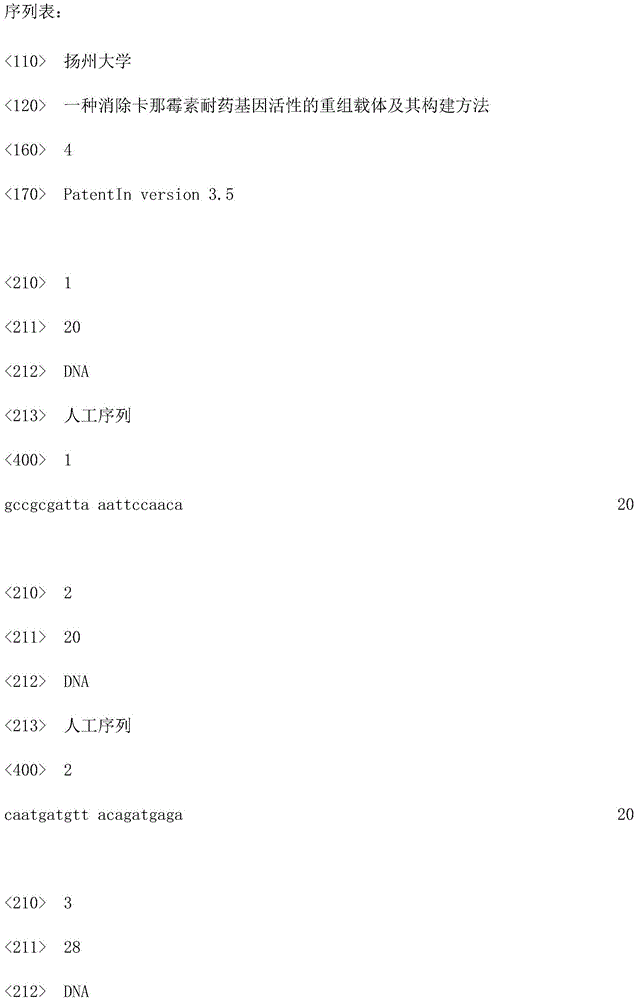Recombinant vector for eliminating activity of kanamycin drug resistance gene and building method of recombinant vector
A recombinant vector, kanamycin technology, applied in the field of pathogenic bacteriology, can solve the problem of bacteria having kanamycin resistance and achieve the effect of eliminating drug-resistant bacteria, important market value, good social and economic value
- Summary
- Abstract
- Description
- Claims
- Application Information
AI Technical Summary
Problems solved by technology
Method used
Image
Examples
Embodiment 1
[0038] Example 1 is the construction method of the recombinant vectors pCas9ΔCam-KR58 and pCas9ΔCam-KR208.
[0039]1. Design of kan gene-specific gRNA:
[0040] pET28a is a commonly used commercial molecular cloning vector. The kan gene sequence in pET28a was directly selected for gRNA target scanning, and 75 potential gRNA sequence target sites were obtained. Following the principle of reducing the off-target probability as much as possible and enhancing the binding affinity with the target gene as much as possible, through the off-target analysis of the host bacterial genome for these potential sites, several gRNA sequences with low off-target probability and high affinity binding to the target gene were selected, and after subsequent experiments The research verified that two gRNA sequences with ideal degrading kan gene activity were identified, named KR58 and KR208 respectively, and their specific nucleotide sequences were as follows:
[0041] KR58: GCCGCGATTAAATTCCAACA ...
Embodiment 2
[0068] Example 2 is one of the application examples of the recombinant vectors pCas9ΔCam-KR58 and pCas9ΔCam-KR208: suppressing the kanamycin resistance of recipient bacteria through transformation. In nature, there is a phenomenon that recipient bacteria directly absorb DNA in the environment, that is, transformation phenomenon.
[0069] When pCas9△Cam-KR58 and pCas9△Cam-KR208 are respectively transformed into Escherichia coli containing pET28a, the specific steps are as follows: first, prepare competent cells of Escherichia coli containing pET-28a; then, take 1 μL of the recombinant vector Add 100 μL of competent cells, mix well, place on ice for 30 minutes, heat shock at 42°C for 75 seconds, place on ice again for 3 minutes, add 800 μL of LB to the centrifuge tube, mix well, place in a shaker at 37°C, shake at 160rpm for 1 hour Then, draw about 50 μL of the bacterial solution and spread it on the LB agar plate, place it upright in a 37°C incubator for 30 minutes, and after t...
Embodiment 3
[0075] Example 3 is the second application example of the recombinant vectors pCas9ΔCam-KR58 and pCas9ΔCam-KR208: inhibition of kanamycin resistance of recipient bacteria through conjugation. In nature, there is a phenomenon of transferring DNA between bacteria through sex pili, that is, the phenomenon of conjugation.
[0076]When pCas9△Cam-KR58 and pCas9△Cam-KR208 were respectively introduced into attenuated Salmonella as donor bacteria, it prepared attenuated Salmonella competent cells, and the recombinant vector transformation and screening methods were the same as the transformed Escherichia coli in Example 2 The competent states were the same, and the conjugation experiments were carried out with Escherichia coli containing pET28a as the recipient bacteria, that is, the attenuated Salmonella containing the recombinant vector and the Escherichia coli containing pET-28a were co-incubated at 37°C for 8 hours, and the Count on LB plates containing antibiotics and kanamycin, r...
PUM
 Login to View More
Login to View More Abstract
Description
Claims
Application Information
 Login to View More
Login to View More - R&D
- Intellectual Property
- Life Sciences
- Materials
- Tech Scout
- Unparalleled Data Quality
- Higher Quality Content
- 60% Fewer Hallucinations
Browse by: Latest US Patents, China's latest patents, Technical Efficacy Thesaurus, Application Domain, Technology Topic, Popular Technical Reports.
© 2025 PatSnap. All rights reserved.Legal|Privacy policy|Modern Slavery Act Transparency Statement|Sitemap|About US| Contact US: help@patsnap.com



